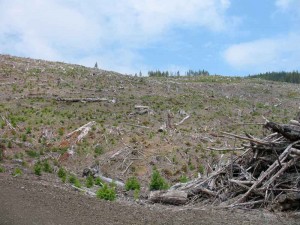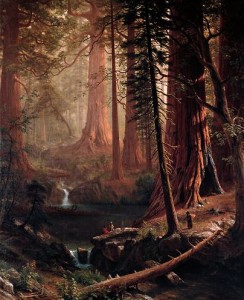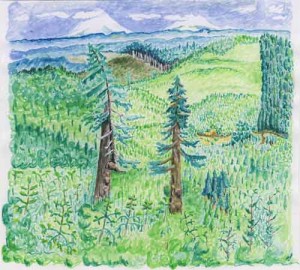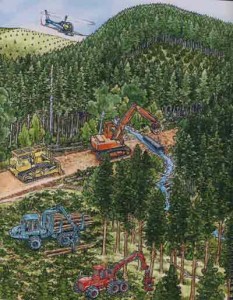You may never appreciate a clear-cut, but there is more to this practice than merely wanton violence perpetrated upon nature.
 For many people the sight of denuded hillsides is both depressing and incomprehensible. I won’t disagree, though I take a more hopeful view and choose to see these ravaged hillsides as evidence of the creative destruction that attends the harvesting of most renewable resource, whether it’s a field of tulips being harvested for your living room vase, windmills blighting the skyline, or biomass being incinerated and releasing more carbon into our atmosphere. All these processes are less than benign.
For many people the sight of denuded hillsides is both depressing and incomprehensible. I won’t disagree, though I take a more hopeful view and choose to see these ravaged hillsides as evidence of the creative destruction that attends the harvesting of most renewable resource, whether it’s a field of tulips being harvested for your living room vase, windmills blighting the skyline, or biomass being incinerated and releasing more carbon into our atmosphere. All these processes are less than benign.
Let me clear, my intent in this blog is to try to explain one aspect of current forest practices. It is not to justify those practices. Since I frequently encounter clear cuts, I would like to understand how the forest practices “rules” are applied and whether they are applied correctly according to the current rule book, the Revised Second Edition of the Oregon’s Forest Protection Laws.
Personally, I do think that trees represent a viable renewable resource. But I don’t believe that current economic realities favor a truly sustainable approach to forestry. In the long run I hope we can agree upon an equitable way of accounting for and including all the “external” costs associated with harvesting trees. This would include the cost of lost bio-diversity resulting from our mono-cultural planting practices.  It should also include a tariff (and in some cases a ban on certain materials) on natural products unsustainably produced and manufactured overseas. It should include a financial disincentive for reducing the quality of our water resources. It should include financial incentives to increase the protections that enhance salmon spawning and endangered species’ critical habitats; conversely it should impose financial disincentives for practices that degrade these habitat areas. Practices that can injury the health of our coastal fisheries should be penalized. And locations with native Indian values should be respected. There should even be some mechanism for addressing the value of these lands as recreational or heritage sites – that value can be degraded by too much cutting, especially in areas with distinct scenic or locational value. Establishing that these aspects of our forests represent real values and that forest practices can impinge upon them represents only the first step. It is probably unrealistic to expect the forest products industry to be able to offset all these values and still maintain it competitiveness in the world markets for wood products. So our solution needs to encourage a market place that is level and fair – that means insisting on international standards for natural resource harvesting that support sustainable harvesting and production practices.
It should also include a tariff (and in some cases a ban on certain materials) on natural products unsustainably produced and manufactured overseas. It should include a financial disincentive for reducing the quality of our water resources. It should include financial incentives to increase the protections that enhance salmon spawning and endangered species’ critical habitats; conversely it should impose financial disincentives for practices that degrade these habitat areas. Practices that can injury the health of our coastal fisheries should be penalized. And locations with native Indian values should be respected. There should even be some mechanism for addressing the value of these lands as recreational or heritage sites – that value can be degraded by too much cutting, especially in areas with distinct scenic or locational value. Establishing that these aspects of our forests represent real values and that forest practices can impinge upon them represents only the first step. It is probably unrealistic to expect the forest products industry to be able to offset all these values and still maintain it competitiveness in the world markets for wood products. So our solution needs to encourage a market place that is level and fair – that means insisting on international standards for natural resource harvesting that support sustainable harvesting and production practices.
I grew up in a forest community that only practiced selective logging – in the Austrian and Bavarian Alps. There logging took the form of continuous thinning and culling of the mature trees, a practice referred to as a “commercial clear-cutting”. In these alpine communities we enjoyed a silviculture that sustained a small coterie of foresters, but the economic impact was a fraction of what the wood products industry represents to the Oregon economy. Of course, the cost of wood in Bavaria and Austria is also much higher than it is in Oregon, which is why homes in the Alps are built of brick and rock, and are considerably more expensive than our wooden homes.
Some might argue that a selective harvesting approach and a more careful use of wood is more sustainable, but clearly such an approach wouldn’t sustain what remains of Oregon’s forest products industry and the rural communities that depend on it. Of course, our wood products industry is vested into the current system. But blaming the forest product producers is pointless. They’re just responding the the existing economic signals in the marketplace. What we should focus on is reforming the pricing mechanisms to include proxy values for the “external” values we wish to preserve or encourage. Whether these values are expressed as fees, quotas, tax incentives, or tariffs will no doubt occupy us for years, but the sooner we “price” these essential ecological values into the marketplace – the sooner we can provide industry with an equitable market place in which they can operate. And that could easily lead to a timber renaissance as equipment-intensive methods are replaced with more labor intensive customized harvesting approaches. And that could greatly enhance the quality of life in rural communities throughout Oregon.
Today, foresters argue that certain species, like our ubiquitous Douglas Fir tree requires lots of sun to grow and succeed in the competitive environment of a crowded forest. The Society of American Foresters argues that clear-cutting is “a method of regenerating an even-aged stand … in a fully-exposed microclimate after … cutting of all trees in the previous stand.” There are currently two accepted arguments for retaining clear-cutting: the economic argument and the growth related characteristics.
 Here again, I personally would argue that we need to change the overall rules that determine pricing in the wood products markets to reflect the other external costs I mentioned in the previous paragraph. But it will take a much longer societal discussion to arrive at a consensus about what costs are valid to include, and how to reflect these costs in a way that permits the forest practices industry to thrive while still absorbing these costs. In the end wood will become more expensive as we add in all the external values we cherish. But that’s what it means when we say we really “value” our forests. To do less is to cheat ourselves, and lose our natural heritage in the bargain.
Here again, I personally would argue that we need to change the overall rules that determine pricing in the wood products markets to reflect the other external costs I mentioned in the previous paragraph. But it will take a much longer societal discussion to arrive at a consensus about what costs are valid to include, and how to reflect these costs in a way that permits the forest practices industry to thrive while still absorbing these costs. In the end wood will become more expensive as we add in all the external values we cherish. But that’s what it means when we say we really “value” our forests. To do less is to cheat ourselves, and lose our natural heritage in the bargain.
We may well decry the deforestation that our modern forestry practices inflict on the land, but we are by no means the first to do this. First let’s remember that forest fires are part of the natural selection process through which our majestic forests arise. Early travelers in the region reported that the summer months were renowned for the smoky haze that filled the Northwest valleys. It was said that by August the smoke from the forest fires was so thick that the Indians living around the Puget Sound were unwilling to canoe beyond sight of the shore, lest they get lost in the smoke. And of course the Indians, themselves were major contributors to that smoke. Most of the open savannahs that typify the Willamette Valley are a direct result of the controlled burning that the Kalapuya Indians used to expose the tarweed seeds and and acorns that lay scattered in the thick grasses that carpeted the valley floor. In the fall they were known to set the open areas ablaze to encourage a winter crop of grasses that attracted game and cleared the underbrush so that they could more easily spot their quarry. On the hillsides they burned the western facing slopes to encourage the growth of berry bushes and to provide clear areas that would attract elk and deer. The Indians were even known to burn fir trees fir for entertainment. On their return trip across continental divide, the Lewis and Clark expedition was entertained by Nez Perce Indians that set fire to some sap-ladened conifers, “which… creates a very sudden and immense blaze from bottom to top… They are a beautiful object in this situation at night. This exhibition reminded me of a display of fireworks”, Lewis wrote in his journals.
 Ok, so we’re not the first to devastate these hillsides with our clearing techniques, but what else should we know about clear-cutting? This has been a question I have been unable to answer until I recently came across the Revised Second Edition of the Oregon’s Forest Protection Laws. This illustrated manual is produced by the Oregon Forest Resources Institute in a style reminiscent of “Where’s Waldo?” Its detailed illustrations will have you searching the forest scenery for the tell-tale red and white striped cap that Waldo wore. Though it seems that Waldo never made into the Oregon Forest, the manual’s many detailed illustrations are a goldmine of information about current Oregon Forest practices.
Ok, so we’re not the first to devastate these hillsides with our clearing techniques, but what else should we know about clear-cutting? This has been a question I have been unable to answer until I recently came across the Revised Second Edition of the Oregon’s Forest Protection Laws. This illustrated manual is produced by the Oregon Forest Resources Institute in a style reminiscent of “Where’s Waldo?” Its detailed illustrations will have you searching the forest scenery for the tell-tale red and white striped cap that Waldo wore. Though it seems that Waldo never made into the Oregon Forest, the manual’s many detailed illustrations are a goldmine of information about current Oregon Forest practices.
And it is from this useful manual that we learn that there are at least four types of clearcut. The first thing to know about clearcuts is that they are regulated by size and the fertility of the area. The North Coast Range generally falls into the most productive site classification for forests. In all cases landowners are required to reforest their timber lands. In addition they are required to keep a certain number of wildlife trees and downed logs to support the regeneration of the diverse species that rely on the forest. It is this final requirement aimed at the preservation of wildlife species that distinguishes the types of clearcuts visible in our forests.
In a Type 1 clearcut (see illustration nearby) the landowner retains approximately 50 trees per acre with an 11″ diameter, this permits him to avoid having to keep additional “wildlife trees” and down logs. He is, however, still obliged to reforest the site within two years. This type of clearcut is infrequently seen. In comparing this category with the following harvest types, I’m not sure I see the a clear distinction between this type of harvest and Type 3.
In a Type 2 clearcut, the landowner elect s to retain an adequate number of “seedlings, sapling and poles” (young tree with diameter up to 10 inches). That’s either 200 seedlings, or 120 saplings or poles, or 53 trees with a minimum 11 inch diameter – or a combination thereof. In this case, the reforestation standard is met and no further reforestation is required. However if the site is larger than 25 acres, it will still require the retention of of two wildlife trees and two downed logs per acre. This type of clearcut is even more rare in my experience. I suspect this is because mature Douglas Fir forests typically suffocate any immature trees that could serve to fulfill the required quota of seedlings, saplings, and poles.
s to retain an adequate number of “seedlings, sapling and poles” (young tree with diameter up to 10 inches). That’s either 200 seedlings, or 120 saplings or poles, or 53 trees with a minimum 11 inch diameter – or a combination thereof. In this case, the reforestation standard is met and no further reforestation is required. However if the site is larger than 25 acres, it will still require the retention of of two wildlife trees and two downed logs per acre. This type of clearcut is even more rare in my experience. I suspect this is because mature Douglas Fir forests typically suffocate any immature trees that could serve to fulfill the required quota of seedlings, saplings, and poles.
 The most common clearcut is the Type 3 harvest. In this case few, if any seedlings, saplings, poles or other larger trees remain. In this instance the harvester must reforest the land within two years and curiously there is no requirement to leave wildlife trees or downed logs – unless the site is larger than 25 acres. Not surprisingly, this is the most common clearcut variety that I have seen.
The most common clearcut is the Type 3 harvest. In this case few, if any seedlings, saplings, poles or other larger trees remain. In this instance the harvester must reforest the land within two years and curiously there is no requirement to leave wildlife trees or downed logs – unless the site is larger than 25 acres. Not surprisingly, this is the most common clearcut variety that I have seen.
 Finally, we have “commercial thinning” which is considered an “Unclassified Harvest”. In this instance the timber harvesters are selectively thinning the forest to permit the remaining trees to have more room and access to sunlight and therefore grow more quickly. In such cases there will be more than 50 trees with a diameter of 11 inches remaining per acre, so no wildlife trees or downed logs will be needed, nor will reforestation be required. This kind of selective logging has been prevalent in those areas that are growing timber for structural purposes, but in recent years many wood products companies have switched to selling their wood into the pulp and fiber markets where there is no premium for tall and strong wood. In these cases, the timber harvesters have stopped thinning and simply harvested these overgrown hedge-rows for their bulk “fiber” value.
Finally, we have “commercial thinning” which is considered an “Unclassified Harvest”. In this instance the timber harvesters are selectively thinning the forest to permit the remaining trees to have more room and access to sunlight and therefore grow more quickly. In such cases there will be more than 50 trees with a diameter of 11 inches remaining per acre, so no wildlife trees or downed logs will be needed, nor will reforestation be required. This kind of selective logging has been prevalent in those areas that are growing timber for structural purposes, but in recent years many wood products companies have switched to selling their wood into the pulp and fiber markets where there is no premium for tall and strong wood. In these cases, the timber harvesters have stopped thinning and simply harvested these overgrown hedge-rows for their bulk “fiber” value.
It’s been said that it’s difficult to see the forest for the the trees, but perhaps the foregoing will help you see the clearcut more clearly despite the lack of trees. And to begin thinking about how to develop a marketplace for forest products that has absorbed the true costs associated with forestry practices, and has deployed the incentives and disincentives needed to preserve the natural resiliency of our ecosystems.

Are you seeing the forest for what it is???? I have hunted in the coast range for 40 years.
old growth forest have 5 to 10 different types of trees growing in them. when clear cut only one type on tree is planted. high breed Douglas fir. Thin logging is not much better,
I hunted a ridge that had been thinned of all the Douglas fir. The only tree left standing were hemlock because the is no market for the wood.
Do you know why it is so hard to find a yew tree in out forest to day? They have been clear cut and over grown with fast growing Douglas fir. I am all for making money, but at what cost???? I see thousands of acres of Oregon forest that are made up of super fast growing doug fir or unwanted hemlock. Where are the divers forest of 1900??
Perhaps I need to edit my comment, but I was not supporting or condoning today’s forest practices. I was repeating the current justifications for commercial tree farming. I am trying to understand the logic behind the current practices, such as why some poles are left standing, or what constitutes a “wildlife” tree. Do I support such logging practices – no. Are the practices that I would advocate economically viable in today’s society – no. So I’m stuck somewhere in between hoping that we begin to adjust our market pricing to reflect the “external costs” that are not factored into today’s timber market.
I believe that eventually we will need to impose fees on our natural resource markets that reflect the larger costs to the environment. We need a carbon tax, a fee to reflect the potential loss of water quality, a fee to offset the loss of salmon spawning grounds and a fee for mono-cultural plantings, and a fee to reflect the loss of recreational opportunities. How these incentives/dis-incentives are imposed will take a generation to argue over. It must also include tariffs on imports produced from natural resources that are not sustainably managed elsewhere. But it will take many of us willing to educate ourselves about the complicated trade-offs to begin to shift the discussion. Right now the discussion has been shifting in the wrong direction with of Oregon Department of Forestry prioritizing the economic contributions that our public forests provide above all other uses, such as water quality, species diversity, etc. And at a time when private forests are cutting as much as they can, we should be insisting that the publicly held forests refrain from a similarly aggressive cutting schedule – and yet there are many Oregon communities whose schools and police depend on these incomes…
If the post came across as supporting clear-cutting, I will need to edit the message to be clear that I am simply trying to understand the current “rules”, not justifying those rules.
Looking through your posts and they are interesting, but also very sad. I can’t believe how much clear cutting is allowed in Oregon, it’s a disgrace, the state looks like a checkerboard scarred with greed.
http://maps.google.com/maps?q=45.847635,-123.453026&ll=45.842912,-123.436289&spn=0.049269,0.12291&num=1&t=h&vpsrc=6&z=14&iwloc=near
Is there anywhere you can go and actually be in an old forest that isn’t just a bunch of fast growing 20 year old tree farms? Is there any old growth left in the state of Oregon? Last I read, and this was years ago, it was less than 2% of remaining tree cover, and those trees are in very remote places that are already on the chopping block, and logging that remaining 2% isn’t even outlawed. When will enough be enough? When a healthy forest and an old tree is a distant legend or just a picture in a book for our children to read about and imagine in a fairy tale way, the same way we read about sabertooth tigers and dinosaurs? What an absolute shame.